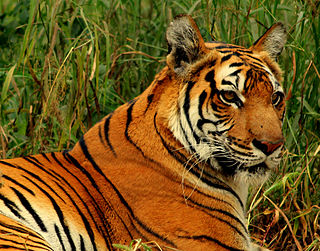
The Western Ghats, also known as the Sahyadri, is a mountain range that stretches 1,600 km (990 mi) along the western coast of the Indian peninsula. Covering an area of 160,000 km2 (62,000 sq mi), it traverses the states of Gujarat, Maharashtra, Goa, Karnataka, Kerala, and Tamil Nadu. The range forms an almost continuous chain of mountains along the western edge of the Deccan Plateau, from the Tapti River to Swamithoppe in Kanyakumari district at the southern tip of the Indian peninsula. The Western Ghats meet with the Eastern Ghats at Nilgiris before continuing south.

Mahseer is the common name used for the genera Tor, Neolissochilus, Naziritor and Parator in the family Cyprinidae (carps). The name is, however, more often restricted to members of the genus Tor. The range of these fish is from Vietnam in the east and China in the north, through Laos, Cambodia, Thailand, Malaysia, Brunei and Indonesia, and across southern Asia including the countries of India, Nepal, Bhutan and Bangladesh within the Indian Peninsula, plus Sri Lanka, Pakistan and Afghanistan. They are commercially important game fish, as well as highly esteemed food fish. Mahseer fetch high market price, and are potential candidate species for aquaculture. Several of the larger species have suffered severe declines, and are now considered threatened due to pollution, habitat loss, overfishing and increasing concern about the impacts of unregulated release of artificially bred stock of a very limited number of species.

India is the world's 8th most biodiverse region with a 0.46 BioD score on diversity index, 102,718 species of fauna and 23.39% of the nation's geographical area under forest and tree cover in 2020. India encompasses a wide range of biomes: desert, high mountains, highlands, tropical and temperate forests, swamplands, plains, grasslands, areas surrounding rivers, as well as island archipelago. Officially, four out of the 36 Biodiversity Hotspots in the world are present in India: the Himalayas, the Western Ghats, the Indo-Burma and the Nicobar Islands. To these may be added the Sundarbans and the Terrai-Duar Savannah grasslands for their unique foliage and animal species. These hotspots have numerous endemic species. Nearly 5% of India's total area is formally classified under protected areas.

Chalakudy River or Chalakudy Puzha is the fifth longest river in Kerala, India. The river flows through Thrissur district, Palakkad district and Ernakulam district of Kerala. The total drainage area of the river is 1704 km2. Out of this, 1404 km2 lies in Kerala and the rest in Tamil Nadu. The length of the river is 145.5 km. Though Chalakudy River in strict geological sense is a tributary of the Periyar river, for all practical purposes it is treated as a separate river by Government and other agencies. The river has gained its name since it flows along the banks of the Chalakudy Town, the major settlement along the course of the river. It is perhaps the most unpolluted and pristine river in the state and even in India due to the limited amount of industries and wastage disposal around it. Chalakudy River and its basin area were one of the most affected rivers during the 2018 Kerala floods.

Francis Talbot Day was an army surgeon and naturalist in the Madras Presidency who later became the Inspector-General of Fisheries in India and Burma. A pioneer ichthyologist, he described more than three hundred fishes in the two-volume work on The Fishes of India. He also wrote the fish volumes of the Fauna of British India series. He was also responsible for the introduction of trout into the Nilgiri hills, for which he received a medal from the French Societe d'Acclimatation. Many of his fish specimens are distributed across museums with only a small fraction deposited in the British Museum, an anomaly caused by a prolonged conflict with Albert Günther, the keeper of zoology there.

The Adan River is a river in Washim District, Maharashtra, India and a principal tributary of the Painganga River.

Fishing in India is a major sector within the economy of India contributing 1.07% of its total GDP. The fishing sector in India supports the livelihood of over 28 million people in the country, especially within the marginalized and vulnerable communities. India is the third largest fish producing country in the world accounting for 7.96% of the global production and second largest producer of fish through aquaculture, after China. The total fish production during the FY 2020-21 is estimated at 14.73 million metric tonnes. According to the National Fisheries Development Board the Fisheries Industry generates an export earnings of Rs 334.41 billion. Centrally sponsored schemes will increase exports by Rs 1 lakh crore in FY25. 65,000 fishermen have been trained under these schemes from 2017 to 2020. Freshwater fishing consists of 55% of total fish production.

The green chromide is a species of cichlid fish that is native to fresh and brackish water habitats in some parts in India such as Kerala, Goa, Chilika Lake in Odisha and Sri Lanka. The species was first described by Marcus Elieser Bloch in 1790. This species and other members of the genus Etroplus are relatively closely related to the Paretroplus cichlids from Madagascar.
Aborichthys tikaderi is a species of stone loach endemic to Arunachal Pradesh, India where it is only known from streams in the Namdapha Wildlife Sanctuary. This fish grows to a length of 10.5 centimetres (4.1 in) SL. The validity of this taxon is in doubt as it is similar to other species of the genus Aborichthys and more research is needed. If it is a valid species then it may be threatened by deforestation and the building of dams.
Aborichthys is a genus of stone loaches found in streams of India with one species also found in Myanmar.

The Nemacheilidae, or stone loaches, are a family of cypriniform fishes that inhabit stream environments, mostly in Eurasia, with one genus, Afronemacheilus found in Africa. The family includes about 790 species.
Aborichthys elongatus is a species of freshwater fish in the stone loach family. A. elongatus is found in North Bengal and Arunachal Pradesh in India.

Tor tor, commonly known as the tor mahseer or tor barb, is a species of cyprinid fish found in fast-flowing rivers and streams with rocky bottoms in India, Bangladesh, Bhutan, Nepal, and Pakistan. It is a commercially important food and game fish.
Aborichthys cataracta is a species of stone loach endemic to streams joining Ranga River in Upper Subanshri District, India. This fish grows to a length of 9.3 centimetres (3.7 in) SL.
Aborichthys verticauda is a species of stone loach found in a stream joining the Ranga River in the Lower Subanshri district in India. This fish grows to a length of 7.8 centimetres (3.1 in) SL.
Aborichthys waikhomi is a species of stone loach found in the Noa-Dihing River, upper Brahmaputra basin in the Namdapha National Park and Tiger Reserve in Arunachal Pradesh, India. This fish grows to a length of 6.8 centimetres (2.7 in) SL.
Aborichthys iphipaniensis is a species of stone loach found in the Iphipani River drainage, upper Brahmaputra basin, Arunachal Pradesh, northeastern India. Habitat: freshwater.
Aborichthys garoensis is a species of stone loach found in the Garo Hills in Meghalaya, India. This fish grows to a length of 9.0 centimetres (3.5 in) SL.
Aborichthys boutanensis is a species of stone loach native to Helmand basin in Afghanistan. This species reaches a length of 5 cm (2.0 in).
Aborichthys bajpaii is a small, benthic fish, observed in the Siang River, Brahmaputra River drainage, in Arunachal Pradesh, India. This new species is distinct from all species described in the genus. A vent and anus that is closer to the caudal fin base than to the snout, 17–22 stripes that converge to the mid-dorsal line which are branched into 26–38 bars along the flank, vertical bars on the caudal fin peduncle, an incomplete lateral line that continues to the end of the pectoral fin, a long head and a deep body, a pectoral fin with 91/2 branched rays, a dorsal fin origin that is equidistant to the snout and to the base of caudal fin, a pelvic fin origin closer to the pectoral fin origin than to the anal fin origin, 2–3 irregular black stripes on the dorsal fin, a maxillary barbel that extends over the posterior edge of the orbit and a truncate caudal fin with 2–4 irregular black stripes.









